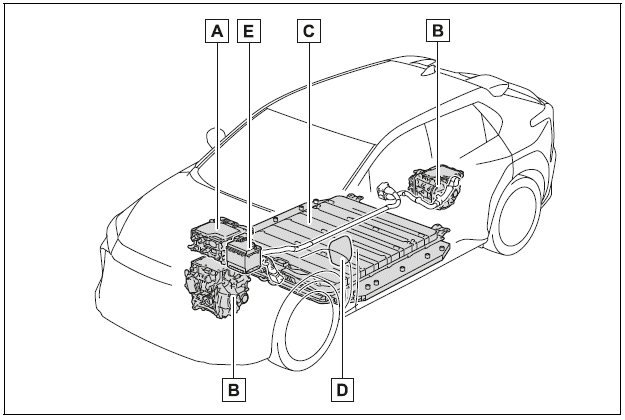Battery electric vehicles (BEVs) operate differently from conventional gasoline-powered cars, relying on stored electricity rather than fuel combustion. This fundamental shift in powertrain technology results in several distinct advantages.
Key Characteristics of Battery Electric Vehicles:
Battery electric vehicles contribute to a cleaner environment while offering advancements in efficiency and driving performance. As charging infrastructure continues to expand, their adoption plays a crucial role in the shift toward sustainable mobility.
System components

The illustration is an example for explanation and may differ from the actual item.
Provides electricity to the electric motor.
Provides electricity to various vehicle systems such as the SRS airbags, headlights, wipers, etc.
*: AWD models only
Regenerative Braking
The electric motor, known as the traction motor, charges the traction battery while braking. This regenerative braking system enhances efficiency by converting kinetic energy into electrical energy, which is stored and reused for propulsion.
Maximizing Driving Range
Charging
Battery electric vehicles are powered by electricity drawn from external sources and stored in the traction battery. Charging methods vary, and drivers can use both public charging stations and household outlets to replenish battery levels.
Key Considerations Before Charging
Regenerative Braking in Action
Energy recovery occurs in the following situations:
This technology plays a crucial role in improving energy conservation and overall vehicle performance by utilizing every opportunity to recover and reuse electricity.
Charging the 12-Volt Battery
The 12-volt battery receives power from the traction battery while the EV system is active or during charging. This auxiliary battery supports essential vehicle functions, such as powering accessories and maintaining onboard electronics.
If the vehicle remains unused for an extended period, the 12-volt battery may discharge due to natural self-drain. Following proper maintenance procedures helps prevent battery-related issues.
Preventive Measures for Long-Term Storage
Maintaining proper charging habits ensures the 12-volt battery remains functional, allowing essential systems to operate efficiently and preventing unexpected power depletion.
Charging the Traction Battery
Maintaining an appropriate charge level for the traction battery is crucial for ensuring optimal vehicle operation. Regular charging helps prevent unexpected disruptions and maximizes driving efficiency.
If the traction battery becomes fully discharged, the vehicle will not be able to operate. To avoid this, always charge the battery promptly when levels become low.
Indicators of a Low Traction Battery
Best Practices for Battery Maintenance
Proper battery management ensures uninterrupted vehicle functionality, contributing to efficient energy use and reliable operation over time.
Sounds and Vibrations Specific to a Battery Electric Vehicle
Battery electric vehicles operate differently from conventional gasoline-powered cars, which can lead to distinct sounds and sensations. Since there is no engine noise or vibration, the vehicle may seem inactive even when it is running. Always verify the "READY" indicator and ensure the shift position is set to P with the parking brake applied when parked.
Normal Sounds and Vibrations
Before and after the EV system starts, various sounds and vibrations may occur. These are normal operating noises and do not indicate malfunctions:
Maintenance, Repair, Recycling, and Disposal
For service, repairs, recycling, or disposal, contact a certified dealer. Avoid attempting to dispose of the vehicle independently, as specialized procedures are required.
Acoustic Vehicle Alerting System
To improve pedestrian awareness, an audible signal adjusts with driving speed to indicate the vehicle’s approach. This sound may be faintly heard from inside the cabin and ceases when the vehicle speed exceeds approximately 23 mph (37 km/h).
Acoustic Vehicle Alerting System Limitations
Understanding these operational sounds ensures a smoother driving experience while maintaining awareness of vehicle functionality.
 Electric vehicle system
Electric vehicle system Electric Vehicle System Precautions
Electric Vehicle System PrecautionsSpecifications, Maintenance data
Dimensions and weights
*: Unladen vehicle
Seating capacity
Seating capacity 5 - (Front 2, Rear 3)
Vehicle identification
Vehicle identification number
The vehicle identification number
(VIN) is the legal identifier
for your vehicle. This is the primary
identification number for
...
Understanding and Adjusting Your 2025 Toyota bZ4X Climate Control System
Modifying the Temperature Settings
To adjust the temperature inside your 2025 Toyota bZ4X, locate the temperature control switch on the climate control panel. Gently push the switch upwards to increase the set temperature for a warmer cabin, or downwards to decrease it for a cooler environment.
It ...